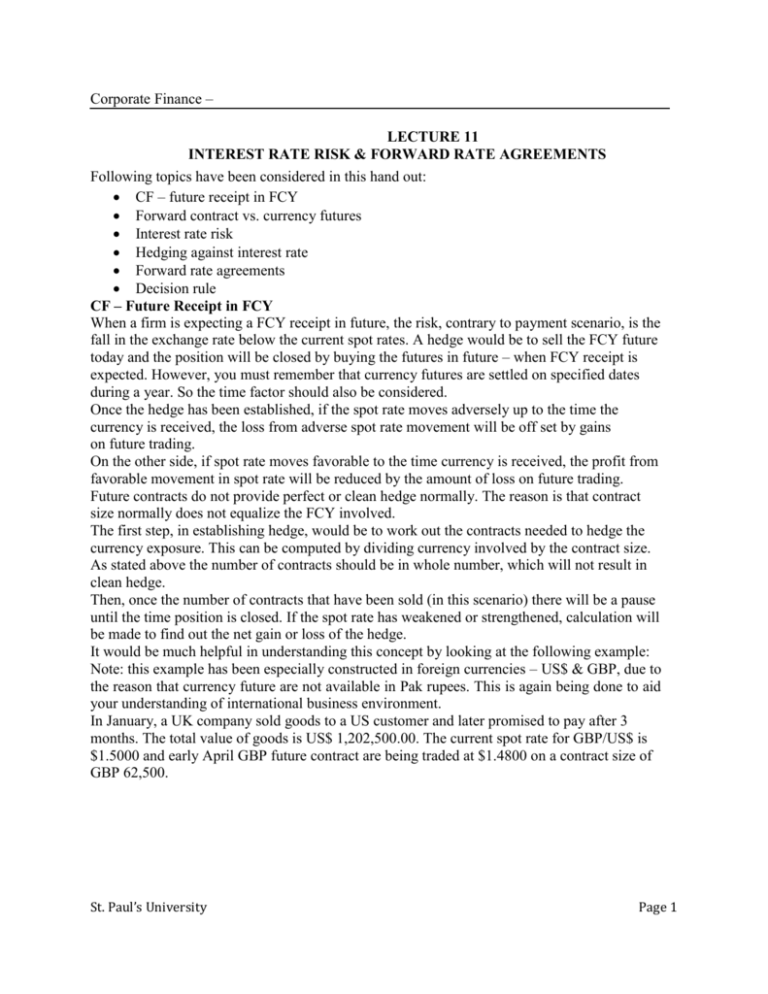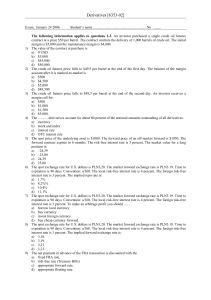Corporate Finance – LECTURE 11 INTEREST RATE RISK
advertisement

Corporate Finance – LECTURE 11 INTEREST RATE RISK & FORWARD RATE AGREEMENTS Following topics have been considered in this hand out: CF – future receipt in FCY Forward contract vs. currency futures Interest rate risk Hedging against interest rate Forward rate agreements Decision rule CF – Future Receipt in FCY When a firm is expecting a FCY receipt in future, the risk, contrary to payment scenario, is the fall in the exchange rate below the current spot rates. A hedge would be to sell the FCY future today and the position will be closed by buying the futures in future – when FCY receipt is expected. However, you must remember that currency futures are settled on specified dates during a year. So the time factor should also be considered. Once the hedge has been established, if the spot rate moves adversely up to the time the currency is received, the loss from adverse spot rate movement will be off set by gains on future trading. On the other side, if spot rate moves favorable to the time currency is received, the profit from favorable movement in spot rate will be reduced by the amount of loss on future trading. Future contracts do not provide perfect or clean hedge normally. The reason is that contract size normally does not equalize the FCY involved. The first step, in establishing hedge, would be to work out the contracts needed to hedge the currency exposure. This can be computed by dividing currency involved by the contract size. As stated above the number of contracts should be in whole number, which will not result in clean hedge. Then, once the number of contracts that have been sold (in this scenario) there will be a pause until the time position is closed. If the spot rate has weakened or strengthened, calculation will be made to find out the net gain or loss of the hedge. It would be much helpful in understanding this concept by looking at the following example: Note: this example has been especially constructed in foreign currencies – US$ & GBP, due to the reason that currency future are not available in Pak rupees. This is again being done to aid your understanding of international business environment. In January, a UK company sold goods to a US customer and later promised to pay after 3 months. The total value of goods is US$ 1,202,500.00. The current spot rate for GBP/US$ is $1.5000 and early April GBP future contract are being traded at $1.4800 on a contract size of GBP 62,500. St. Paul’s University Page 1 UK supplier is exposed to exchange risk on future income of $1,202,500.00. If sterling weakens, UK trader will gain but if sterling strengthens, he will lose. The UK supplier can set up a futures position by hedging the risk of strengthening of sterling or weakening of US$. To do this the UK seller will sell US$ using sterling futures. A sterling future is for GBP 62,500/- and the buyer of the sterling future is buying sterling or selling US$ Buyer needs to buy sterling future. At the future price of $1.4800 the $ receipt after 3 months will be worth: = $1,202,500.00 /1.4800 = GBP 812,500 The UK trader needs to buy: 812,500 / 62,500 per contract = 13 contracts The overall financial position will be: Income from trading Ksh.1,202,500/= Profit on future selling: 400 ticks x 6.25 x 13 = Ksh. 32,500/= Total value = Ksh. 1,235,000/= Exchange into sterling at spot rate of ksh.1.52/GBP: Ksh.1,235,000/1.52 = GBP 812,500 Effective ex rate is Ksh.1,202,500 / 812,500 = ksh.1.48 Forward contract vs. Currency future In currency futures, commodity exchanges are involved and credit risk is eliminated. However, a forward contract is made between parties and each party needs to confirm the credit worthiness of each other. Reversal of currency future is very simple. Large buyers and sellers exist. Reversing forward contract is difficult. Original parties have to set off the deal. Future currency contract become a “commodity” and reversing does not require original parties. Size of contract: no size restriction is placed in forward contract and is up to parties to deal or contract in the magnitude they like. However, in future currency contract the size is predetermined or fixed. In this scenario, perfect hedge is not possible. In forward contract, no margin is required but in currency future parties have to put an initial margin. Interest Rate Risk Management: Apart from exchange rate fluctuations, another source of risk in foreign exchange market is interest rate risk. It is the risk of incurring losses or gains due to adverse / favorable movements in interest rates. For example, a firm is expecting FCY receipts / payment and this income/payment will depend on interest rate at that time. The firm’s assets (some) whose value is sensitive to interest rates. Firms and companies dealing in money market hedges are the most effected by the interest rate variations. Most of banks and financial institutions have significant exposure based on shortterm floating interest rates. St. Paul’s University Page 2 For example, some large companies have forecasts of receiving handsome amounts of cash, or have forecasted surplus cash in short term. Income from short-term investments will be dependent upon the interest rates and if the short-term interest rates are falling then there will be a loss in terms of lower interest income from investment. The other side, if a company is planning to borrow at variable rate of interest, the interest amount charged each time varying according to whether short-term interest rates have risen or fallen since the previous payment. To quote another example how interest rate fluctuations affect the financials of the company, a company may have invested in bonds and any change in interest rate will affect the value of investment in balance sheet. Examples of interest rate risk – short term investments, investment in bonds, borrowings in short term – variation in short term interest rate. Interest rate risk is higher when interest rates are extremely sensitive and their future direction is unpredictable. Hedging against the interest rate risk 1) Forward rate agreements 2) Interest rate futures 3) Interest rate options 4) Interest rate swaps We shall discuss these individually. Forward Rate Agreements – FRA This is a contract and a financial instrument that is used has hedge against interest rate adverse fluctuations on deposit or loans starting in near future. This resembles to forward exchange rate agreements to fix the exchange rates. Features of FRAs: It is between a bank and a client for fixing future interest rate on notional amount of loan or deposit. The loan or deposit is for a stated period starting on a specified time in future. The size of the notional loan or deposit is agreed between the bank and the client. FRAs are cash settled. At settlement date buyer and seller must settle the contract. The FRA rate for three months loan/deposit starting in a 6 months time is normally expressed as 6v9 FRA. The buyer of a FRA agrees to pay fixed interest rate (FRA rate) on notional loan/deposit. At the same buyer will receive interest on notional loan/deposit at benchmark rate of interest. On the other side, seller of FRA agrees to pay interest on the notional amount at benchmark rate and receives interest at a fixed rate. Decision Rule: When a FRA reaches its maturity – the settlement date, both the seller and buyer must settle the contract. If the fixed rate in the agreement is higher than the reference rate (may be KIBOR), the buyer of the FRA makes a cash payment to the seller. The payment is for the amount by which the FRA rate exceeds the reference rate. If the fixed rate in the agreement is lower than the reference rate, the seller of the FRA makes a cash payment to buyer – exactly the reverse of above. The payment is for the amount by which the FRA rate is less than the reference rate. St. Paul’s University Page 3 FRA offer companies the facility to fix future interest today either on short-term borrowing or deposit for an agreed future period. An effective interest rate can be fixed on future short-term borrowing by buying an FRA. Alternatively, an effective interest rate can be fixed on short-term deposit or investment by selling FRA. Mechanism: Step 1: Understand the scenario confronted to the company. This means that weather the company plans to borrow or will have surplus cash to invest. The hedge will depend on that scenario. If the company plans to borrow in future then it will need to buy FRA and if company intends to put some investment in short term deposit, it needs to sell FRA. Step 2: The bank or some vendor will be identified who trades in FRAs and terms are negotiated. Terms generally include the duration of notional deposit, amount of notional deposit and rate. Step 3: On the settlement date, there will be cash payment / receipt from/to bank to company based on the prevalent rate. Calculations will return the amount to be paid or received. St. Paul’s University Page 4







